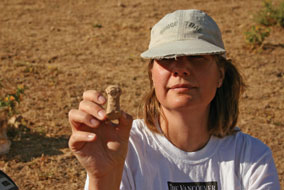
Archaeologist Lisa Cooper holds a baked clay animal figurine - photo by Bernard Lachance UBC Reports | Vol. 52 | No. 9 | Sep. 12, 2006
Exploring Syria’s Ancient Past
Despite the hot sun, which at 10:30 in the morning is already mercilessly beating down upon me, I can’t take my eyes off the ground in front of me, where there lies a delicate fragment of pottery painted with black bands and white wavy patterns. I know from similar vessels encountered on other archaeological sites that this was once part of a drinking goblet. A few steps away, I see another similarly decorated pot sherd, and then another, and I know that that I am walking over a site that supported a human settlement dating back more than 4,000 years.
Together with Gillian Gunter, my graduate student from the Dept. of Classical, Near Eastern and Religious Studies at UBC, we continue to pick up these lovely sherds, depositing them in our red buckets, and moving on to the next stretch of terrain, which is certain to yield further fascinating artifacts. Later in the day, we will return to our comfortable dig-house and refresh ourselves with a cool shower and clean clothes. Then we’ll embark on the task of cataloguing, drawing and photographing our distinctively decorated cup fragments, attempting to establish when precisely they were produced, and what they tell us about the people who once used them so long ago.
This is my eleventh season of archaeological work in Syria, and I still get an incredible feeling of excitement when I travel through this country, knowing that it has supported countless centuries of human habitation. This is especially the case of the Ghab region of the Orontes River Valley of Western Syria, where I am currently working as part of a Syro-Canadian archaeological team under the direction of Michel Fortin of Laval University.
Only a few kilometres away to the east lies a site where some of our early human ancestors several hundreds of thousands of years ago butchered animal meat with crudely-shaped stone axes. I can see another site directly to the north, where in a more recent period of antiquity, the Romans constructed a magnificent city known as Apamea, adorning it with a stunning avenue of majestic stone columns. Nearby, there also lies the medieval castle of Qal’at Mudiq, which the Arabs fortified in the 11th century AD in order to check the advance of Crusaders on their long march towards Jerusalem.
Judging by its size, the very site upon which I am now standing would have witnessed the long sweep of human history. Rising up to 25 metres above the level of the surrounding plain, this artificial hill — or “tell” as it is called in Arabic — was formed by successive settlements, each built and re-built on top of the other through time. Our archaeological team is especially interested in these kinds of tells. Using satellite images, topographical maps and state-of-the-art GPS equipment, we have been able to locate and explore 11 such tells, and by the end of the season we will have completed a survey of 19 of these ancient sites. Although we are only collecting pottery from the surface of the mounds in order to ascertain the periods during which they were occupied, I can’t help but imagine the inestimable wealth of human antiquity that lies beneath my feet, waiting to be uncovered by future excavators.
As I stoop to pick up one more piece of pottery, I look down the slope, where I see my two Syrian colleagues, Nadir and Mossab, excitedly peering over a Byzantine stone block which bears an ornately carved cross on one of its sides. As representatives of the General Directorate of Antiquities and Museums in Syria, Nadir and Mossab bring to our team a first-rate knowledge of the Orontes Valley, combined with many years of archaeological field experience. Each day Gill and I find ourselves greatly encouraged by their good humour and high spirits despite the withering heat and the dust. Tonight we will go to Nadir’s house, built in the shadow of Qal’at Mudiq’s towering walls, where we will dine on a feast of roast chicken and rice carefully spread out on a carpet on the floor.
Over cups of sweet tea served to us by Nadir’s inquisitive children, we will chat animatedly about our archaeological adventures, and friends and family in Syria and in far-off Canada.
Leaning back on a comfortable cushion, I reflect on how collegial and productive our partnership with the Syrians has been despite the fact that other parts of the Middle East are now embroiled in political upheavals and unrest. I think about how happy I will be to return to Syria again in future years so that I can continue my exploration of the country’s rich past and delight in the discovery of its antiquities in the company of those who have become my good friends.
|
 |
 |
 |
From: Assoc. Prof. Lisa Cooper
Orontes River Valley, Western Syria
Lisa Cooper is an Associate Professor in the Dept. of Classical, Near Eastern and Religious Studies. |
|
